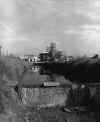1970
1970s During this period, all Army nuclear weapons training was transferred to OMMCS, Redstone Arsenal. The Department of Justice also provided funds for the addition of hazardous devices training for selected U.S. and foreign civilian law enforcement personnel.
1970 Studies leading to the development of the XM65 TOW armament subsystem for the AH-1 series COBRA helicopter were started during this fiscal year.

January 70 The first two Ordnance LCSS detachments--the 116th Ordnance Detachment and the 223d Ordnance Detachment--were deployed to Europe after being activated and completing unit training at RSA. These two units would provide direct support to the V and VII Corps in Europe. The 563d Ordnance Company deployed to Europe in March.
22 January 70 The ADCCS and Target Missiles Product Offices were officially discontinued after the issuance of the PM charter for the ADCAT Project Office.
22 January 70 The PERSHING Project Office received the Federal Republic of Germany's official acceptance of the SWAP Program.
2 March 70 The first MICOM element to be organized according to the standard commodity command concept was the Management Information Systems Directorate (Provisional), the mission of which was to develop and implement a management data systems program within MICOM.
17 March 70 The Alabama Space and Rocket Center was formally dedicated. It was located on a 35-acre tract on the northern rim of Redstone Arsenal deeded by the Secretary of the Army to the Alabama Space Science Commission. Both the Army and NASA made extensive loans of equipment to the center.
18 March 70 Project SWAP covering U.S. PERSHING 1a deployments was completed, about 15 days ahead of schedule.
31 March 70 The MARS II Product Office was disestablished because of a lack of funds to continue system development.
31 March 70 As part of DOD's plan to reduce spending, ARADCOM inactivated 28 NIKE HERCULES batteries in Pennsylvania, Maryland, Washington, D.C., Connecticut, Massachusetts, New Jersey, California, New York, Wisconsin, Illinois, Virginia, Indiana, Ohio, and Michigan.
31 March 70 EXPLORER I, launched by ABMA on 31 January 58, re-entered the earth's atmosphere. The satellite had ceased usable transmissions 63 days after launch.
5 April 70 The airborne TOW was transferred from the Aircraft Weapons Commodity Office to the TOW Project Office.
6 April 70 The SERGEANT Commodity Office was discontinued.
6 April 70 The Land Combat Special Items Management Office (Provisional) was organized to exercise full-line authority over the SERGEANT Commodity Office, the Land Combat Weapons Commodity Office, and the Aircraft Weapons Commodity Office.
15 April 70 A Dental Detachment was organized and assigned to MEDDAC to provide dental services for all eligible personnel in the RSA area.
2 June 70 AMC Headquarters directed MICOM to assume responsibility for planning, procuring, producing, and processing motion pictures as well as providing visual services. To carry out this mission, the Army Pictorial Center at Long Island City, New York, was transferred to Redstone Arsenal.
29 June 70 MICOM experienced its first major RIF as part of an overall DOD cutback. Civilian spaces were cut by 1,370 and military authorizations were decreased from 1,052 to 930. The final number separated from civilian service as a result of RIF procedures was 350, with 31 additional employees to be let go on 5 August 70.
30 June 70 All technical activities at the Rohm and Haas Company facilities on RSA were completed. After 20 years on the arsenal, the contractor closed down its operations because of a lack of funds. Efforts to decontaminate and lay-up facilities continued under existing contracts extending to 7 January 71.

30 July 70 Olin Mathieson Chemical Company announced that it would cease producing DDT at Redstone Arsenal.

30 August 70 The Directorate for Plans and Analysis (Provisional) was established to serve as the principal staff office for immediate and long-range planning, systems analysis, and management studies. Its provisional status was terminated on 4 January 71.
September 70 Three TOW training battalions became operational, replacing the M40 106mm recoilless rifle and the French ENTAC. By 30 September, the Army had completed phaseout of the ENTAC after the TOW missile was standardized. The M40 106mm rifle was redistributed to the reserves and depot stocks as it was replaced by the TOW.
September 70 The distribution of TOW launchers to USAREUR began. The first USAREUR unit was equipped by 13 November 70.
30 September 70 The mission and functions of the U.S. Army Field Office, USAF Western Test Range, were transferred from MICOM's jurisdiction to the SAFEGUARD System Command.
October 70 MICOM requested that the XM3 subsystem, which fired the 2.75-Inch rocket, be type classified obsolete. It was the first antiaircraft armament subsystem approved by DA.
November 70 The first tactical basic TOW missiles were deployed. The first USAREUR TOW unit was equipped on 13 November.
November 70 MICOM began realigning its organizational elements into a standard structure being adopted by each of AMC's major commodity commands. The process took about 3 months to complete.
December 70 The Gorgas Laboratories, a government-owned, contractor-operated (GOCO) facility at RSA operated by Rohm and Haas Company, were closed, terminating a 20-year continuous exploratory development program which produced a number of significant accomplishments for the Army. The Propulsion Directorate began using part of these facilities for propellant processing and motor evaluation.
1 December 70 As part of the standard commodity command reorganization effort, the LANCE and SAM-D Project Offices were removed from MICOM's jurisdiction and established directly under AMC Headquarters. However, both organizations continued to be located at Redstone Arsenal, and MICOM essentially supported them as it did its own project offices.
1 December 70 The Occupational Health Office, MEDDAC, was redesignated the U.S. Army Civilian Employees Health Clinic, RSA.

Excellence in Missilery:
Introduction,
1962,
1963,
1964,
1965,
1966,
1967,
1968,
1969,
1970,
1971,
1972,
1973,
1974,
1975,
1976,
1977,
1978,
1979
